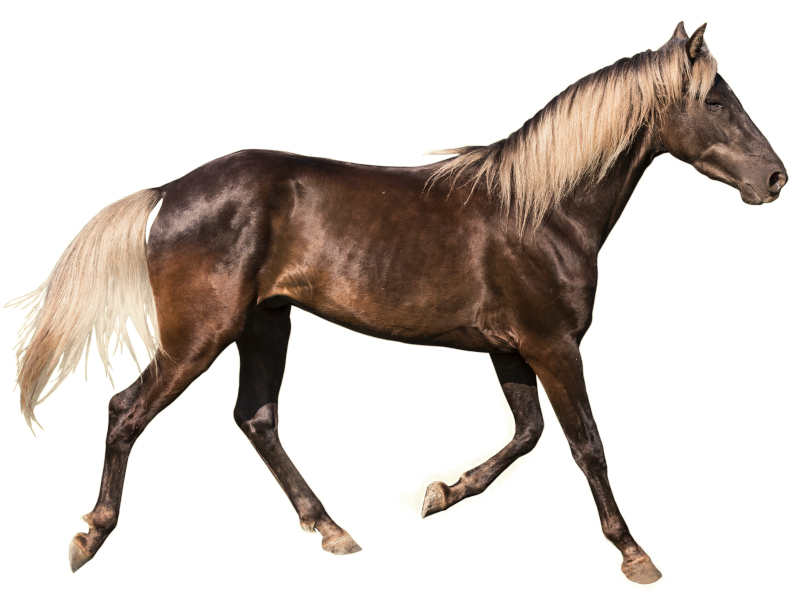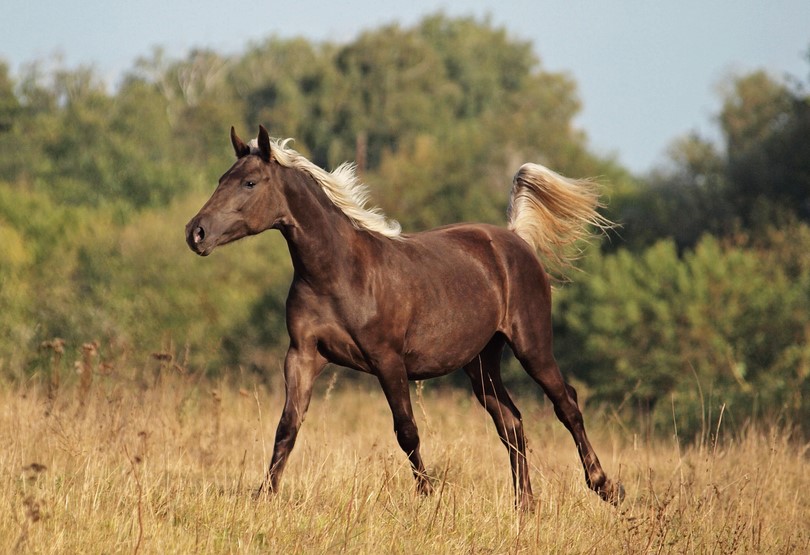Quick Summary

Click here for Price and Turnaround Time
Phenotype: Silver is a coat color dilution found in various breeds that dilutes black/brown pigment. On a black base coat color, silver will dilute the mane and tail to a flaxen or silver gray and will dilute the coat to a chocolate color that may be accompanied by dappling. On a bay base coat color, the silver dilution will dilute the mane and tail to a flaxen or silver gray and will dilute the dark points (these are known as red silvers or bay silvers). Silver on a chestnut background will have no impact on coat color.
The silver dilution is also associated with an inherited ocular syndrome known as Multiple Congenital Ocular Anomalies (MCOA).
Mode of Inheritance: Autosomal dominant
Alleles: N = Normal or non-silver, Z = Silver; Multiple Congenital Ocular Anomalies (MCOA)
Breeds appropriate for testing: Appaloosa, Arabian, Ardenne, Finnhorse, Gypsy Cob, Gypsy Vanner, Icelandic Horse/Pony, Kentucky Mountain Horse, Miniature Horse, Missouri Foxtrotter, Morgan Horse, Mountain Pleasure Horse, Norwegian Nordland, Paint Horse, Quarter Horse, Rocky Mountain Horse, Saddlebred, Shetland Pony, Swedish Warmblood, Welsh Pony, related breeds
Explanation of Results:
- Horses with N/N genotype will not have the silver dilution or MCOA and cannot transmit this silver dilution variant to their offspring.
- Horses with Z/N genotype will be silver dilute and may transmit this silver dilution variant to 50% of their offspring. Matings with N/N genotype will result in a 50% chance of producing a foal with the silver dilution. These horses will also likely have a less severe form of MCOA.
- Horses with Z/Z genotype will be silver dilute and will transmit this silver dilution variant to all of their offspring. Matings with any genotype are predicted to produce silver foals. These horses will also likely have a more severe form of MCOA.
Chestnut horses with one or two copies of the silver dilution will not be silver dilute but are likely to have ocular abnormalities related to MCOA.
Horse Coat Color Panel
$85 per animal
Full Color/Pattern Panel
$155 per animal
Shetland Pony Coat Color Panel
$100 per animal
Sample Collection
Horse DNA tests are carried out using cells from the roots of a hair sample (roughly 20-40 hairs).
1. Grab about 10 hairs at the base.
2. Wrap the hairs around your finger and give it a quick pull.
3. Check the ends to make sure the pulled hairs have roots.
4. Repeat the process until you have collected about 20-40 hairs with intact roots.
5. You can choose different places on the mane or tail. NOTE: For foals, we recommend pulling all hairs from the tail only.
6. Tape the hairs to the submission form and fold the form along the dotted line to protect the sample. Do not use ziploc bags as they can cause condensation that allows mold to grow on the hair.
7. Place the folded form containing the sample in a paper envelope and mail it to the laboratory.

The horse silver dilution lightens black/brown pigment but has no effect on red/yellow pigment. The mane and tail are typically lightened to flaxen or silver gray color but may darken with age on some horses. Horses with the silver mutation may have dappling in their coat. A solid black horse with the silver dilution will be chocolate-colored with a lightened mane and tail. A bay horse with the silver dilution will have lightened black pigment on the lower legs and flaxen mane and tail. Silver dilution is inherited as a dominant trait. This means that 1 copy of the silver allele is sufficient to produce the dilute phenotype in black-pigmented horses. Silver occurs in Rocky Mountain Horses and related breeds, Shetland Ponies, Icelandic and Morgan Horses, among others.
The gene responsible for silver dilution is PMEL17 and a mutation in exon 11 causes the dilute phenotype described above.
The silver mutation is associated with Multiple Congenital Ocular Abnormalities syndrome (MCOA), which is characterized by several different ocular defects occurring in the anterior and posterior segment of the eye. The severity of the syndrome is dosage related. Horses with 1 copy of silver (heterozygous) have less severe signs, typically in the form of cysts (or fluid filled vesicles). Horses with 2 copies of silver (homozygous) have cysts and additional abnormalities such as enlargement of the cornea, abnormally formed iris and/or retina, among others. Research suggests that there may be a progressive change in vision in horses with the silver mutation.
Testing for the silver dilution/MCOA is important in assisting clinicians, owners, and breeders in identifying affected horses. Chestnut horses with the silver dilution will show no difference in coat color phenotype but these horses will likely have MCOA therefor testing is especially recommended for chestnut horses produced from silver matings. Results of the test are helpful to identify those animals that should be clinically evaluated. Breeders can use results from the test as a tool for selection of mating pairs to avoid producing homozygous (Z/Z) horses.
